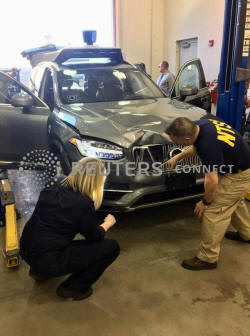|
Safety driver in fatal Arizona Uber
self-driving car crash charged with homicide
 Send a link to a friend
Send a link to a friend
[September 16, 2020] By
David Shepardson
WASHINGTON (Reuters) - The back-up safety
driver behind the wheel of a self-driving Uber Technologies <UBER.N>
test vehicle that struck and killed a woman in Tempe, Arizona, in 2018
was charged with negligent homicide, prosecutors said on Tuesday. |

National Transportation Safety Board (NTSB) investigators examine a
self-driving Uber vehicle involved in a fatal accident in Tempe,
Arizona, U.S., March 20, 2018. A women was struck and killed by the
vehicle on March 18, 2018. National Transportation Safety Board/Handout
via REUTERS |
|
Rafael Vasquez, age 46, who is also known as Rafaela, pleaded
not guilty on Tuesday after being charged in the death of Elaine
Herzberg on Aug. 27, court records show. She was released
pending trial set for February 2021.
Herzberg died after she was struck while walking a bicycle
across a street at night. The first recorded death involving a
self-driving vehicle prompted significant safety concerns about
the nascent autonomous vehicle industry.
Uber declined comment. A lawyer for Vasquez did not immediately
respond to a request to comment.
A Tempe police report said Vasquez was repeatedly looking down
instead of keeping her eyes on the road. Prosecutors in March
2019 said Uber was not criminally liable in the crash.
“Distracted driving is an issue of great importance in our
community,” said Maricopa County Attorney Allister Adel. "When a
driver gets behind the wheel of a car, they have a
responsibility to control and operate that vehicle safely."
Police said previously the crash was "entirely avoidable" and
that Vasquez was streaming "The Voice" TV program at the time of
the crash.
In November, the National Transportation Safety Board (NTSB)
faulted Vasquez's inactions and Uber for inadequate attention to
safety and decisions in the company's autonomous vehicle
development.
The NTSB said the probable cause was Vasquez's failure to
monitor the driving environment “because she was visually
distracted throughout the trip by her personal cell phone." She
was supposed to act in the event of an emergency.
Uber made a series of development decisions that contributed to
the crash's cause, the NTSB said. The software in the modified
Volvo XC90 did not properly identify Herzberg as a pedestrian
and did not address "operators’ automation complacency."
Uber deactivated the automatic emergency braking systems in the
Volvo XC90 vehicle and precluded the use of immediate emergency
braking, relying instead on the back-up driver.
(Reporting by David Shepardson; Editing by Aurora Ellis and
Stephen Coates)
[© 2020 Thomson Reuters. All rights
reserved.] Copyright 2020 Reuters. All rights reserved. This material may not be published,
broadcast, rewritten or redistributed.
Thompson Reuters is solely responsible for this content.

|
|
|





